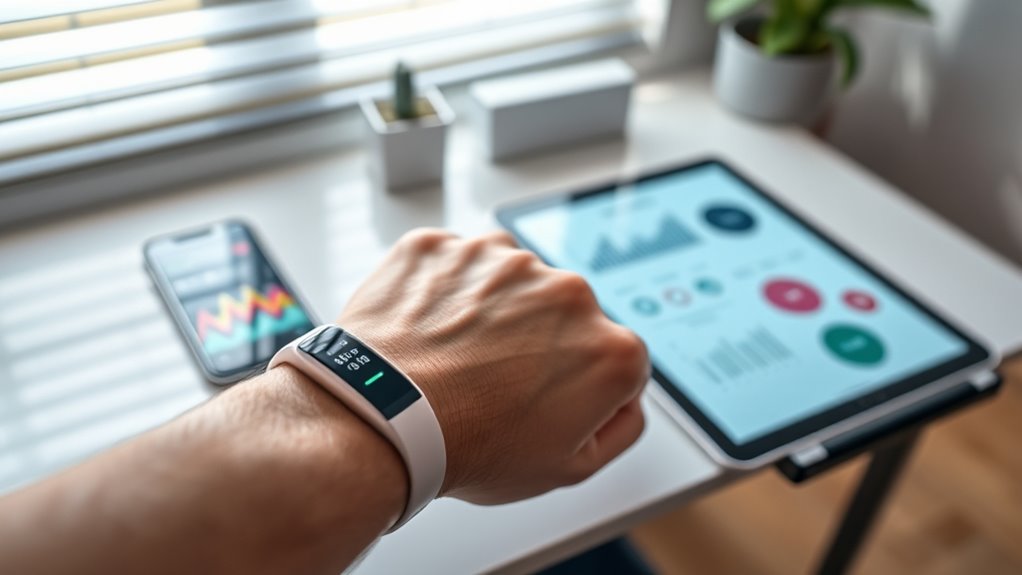To create a personalized wellness routine using wearable data, start by tracking your sleep patterns and making adjustments to improve sleep quality, like establishing a calming bedtime routine. Use heart rate and activity data to balance exercise and reduce stress, while monitoring diet through hydration and oxygen levels to make nutrient-rich choices. Incorporate mindfulness practices based on stress insights, and plan activities during *best* times. Keep refining your routine as you discover what works *most* for your body—there’s more to explore ahead.
Key Takeaways
- Analyze sleep data to identify patterns and adjust bedtime routines for improved rest and mental clarity.
- Monitor heart rate variability and stress levels after meals to optimize dietary choices and nutrient intake.
- Use activity tracking to tailor exercise intensity and incorporate restorative practices like yoga for balanced energy.
- Integrate mindfulness practices based on wearable feedback to enhance sleep quality and reduce stress effectively.
- Schedule leisure and support activities during optimal times, using wearable insights to maintain physical and mental harmony.

In today’s tech-driven world, wearable devices have become powerful tools for personal health management. They don’t just track steps or calories anymore; they provide detailed insights into your body’s rhythms, helping you craft a wellness routine tailored specifically to your needs. One of the most effective ways to do this is by leveraging the data from your wearable to refine your mindfulness practices and make smarter nutritional adjustments. When you pay close attention to your wearable’s feedback, you can identify patterns that reveal how your body responds to different activities, foods, and stress levels, giving you the knowledge to optimize your overall well-being.
Start by examining your sleep data. Wearables monitor your sleep quality, duration, and sleep stages, offering a clear picture of how restorative your nights are. If your device indicates frequent awakenings or shallow sleep, you can experiment with mindfulness practices like meditation or deep breathing exercises before bed. These techniques can reduce stress and promote relaxation, improving your sleep quality over time. By consistently integrating mindfulness into your nightly routine based on your wearable’s insights, you create a cycle that enhances rest, energy, and mental clarity. Additionally, understanding the support hours of various entertainment and parks can help you plan visits during less crowded times, ensuring a more relaxed experience.
Monitoring sleep data helps identify patterns, enabling mindfulness practices to enhance rest and mental clarity over time.
Your wearable data can also guide nutritional adjustments. For example, if your device shows elevated heart rate variability or signs of stress after certain meals, it’s a cue to evaluate your diet. You might discover that reducing processed foods or increasing your intake of nutrient-dense fruits and vegetables helps stabilize your body’s responses. Some wearables track blood oxygen levels or hydration status, which can inform you about how well your body is coping with your diet. Making incremental nutritional adjustments based on these insights allows you to better support your physical and mental health, leading to increased energy and improved mood.
Additionally, tracking your activity levels and correlating them with your mood and stress levels can help you fine-tune your exercise routine. If your wearable indicates that moderate activity reduces stress and boosts your mood, you can prioritize those workouts. Conversely, if high-intensity sessions seem to cause fatigue or irritability, you might scale back or incorporate more restorative activities like yoga or stretching. Over time, this personalized approach ensures your wellness routine evolves in harmony with your body’s needs.
In essence, your wearable device acts as a constant health companion, providing real-time data that empowers you to make smarter choices. By integrating mindfulness practices and nutritional adjustments based on your wearable’s feedback, you set the stage for a sustainable and highly personalized wellness routine. This proactive approach helps you stay in tune with your body, fostering a healthier, more balanced life where your habits align seamlessly with your unique physiology. Knowing the support hours of entertainment venues can also help you plan your leisure activities more effectively.
Frequently Asked Questions
How Do I Choose the Best Wearable Device for My Needs?
To choose the best wearable device for your needs, consider device compatibility with your smartphone and apps, ensuring seamless syncing. Look for a device with good battery longevity so it lasts through your day or workouts without frequent charging. Think about your fitness goals and features like heart rate monitoring or sleep tracking, and pick a device that aligns with those needs. This way, you’ll stay motivated and get the most out of your wellness routine.
Can Wearable Data Predict Future Health Issues Accurately?
Wearable data can provide valuable insights, but its predictive accuracy for future health issues isn’t foolproof. While it helps with health forecasting by detecting early signs, it can’t guarantee precise predictions. You should use this data as a supplement, not a definitive forecast, and always consult healthcare professionals for concerns. Stay proactive, but remember, wearable devices enhance awareness rather than replace medical advice.
How Often Should I Update or Calibrate My Wearable Device?
You should calibrate your device whenever you notice inconsistent readings or after updates. Regularly updating your device’s firmware guarantees peak performance and accuracy. Typically, check for updates monthly or as recommended by the manufacturer. For calibration, follow the device instructions, especially if you’re tracking specific metrics like heart rate or sleep. Staying consistent with update frequency and calibration helps you get reliable data for your wellness routine.
Are There Privacy Concerns With Sharing Wearable Health Data?
Yes, privacy concerns exist when sharing wearable health data. You should guarantee data security by choosing reputable providers that encrypt your information. Additionally, check their consent management policies to understand how your data is used and shared. Always read privacy agreements carefully, and control your settings to limit data sharing. Being informed helps you protect your health information while enjoying the benefits of personalized wellness insights.
What Lifestyle Changes Can Enhance the Benefits of Wearable Insights?
Think of your wellness journey as tending a garden; your wearable data is the watering can. To boost its benefits, you should make diet modifications and focus on stress management. These act like nourishing sunlight and fertile soil, helping your insights flourish. By consistently nurturing these areas, you enhance your overall health, making your personalized routine more effective and sustainable.
Conclusion
By paying close attention to your wearable data, you gently steer your wellness journey in the right direction. Small adjustments, like better sleep habits or mindful movement, can quietly enhance your overall well-being. Remember, it’s not about perfection but progress—like tending a delicate garden. Embrace these subtle changes, and over time, you’ll find your routine becoming a natural, joyful part of your daily life, nurturing your health with kindness and care.









